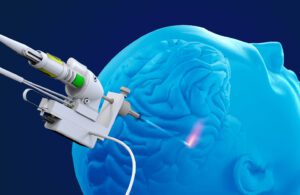Monteris Medical recently raised $35 million as it continues to advance its minimally invasive robotic brain surgery system.

The Minnetonka, Minnesota–based company reported a $13.5 million raise in an SEC Form D filed on Sept. 15. But in an article published yesterday in the Star Tribune of Minneapolis, CFO Jim Erickson said the equity financing range was actually $35 million.
“The first half of this year was more challenging than the year before. It took longer than we would have hoped,” Erickson told the Star Tribune. He later added that the life sciences space is proving to be a durable investment space, even amid the present economic hurdles.
Monteris Medical is among a host of companies big and small that are seeking to innovate in a surgical robotics space that has long been dominated by Intuitive. [Intuitive CEO Gary Guthart will deliver a keynote at DeviceTalks West, Oct. 19–20, 2022, in Santa Clara, California. Register here.]
Monteris designed its NeuroBlate minimally invasive surgical robot system for controlled laser thermotherapy, known as laser interstitial thermal therapy (LITT). More than 80 hospitals across the U. S. and Canada have used the NeuroBlate System since its market release in 2013.
NeuroBlate uses MRI-guided laser light to ablate (destroy) brain lesions or unwanted tissue. Patients treated with NeuroBlate have had conditions including epilepsy, gliomas, brain metastases and radiation necrosis.
New clinical trial kicks off for Monteris Medical
Also in September, Monteris Medical announced the first patient enrolled in its REMASTer (Recurrent Brain Metastases After Stereotactic Radiosurgery [SRS] Trial) clinical trial.
Researchers designed the randomized controlled study to investigate NeuroBlate-System-delivered LITT as an early intervention for radiographically progressive brain metastases. The goal of REMASTer is to provide Level I evidence to guide treatment. The company described the patient population in the space as complex.